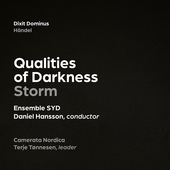Storm: Qualities Of Darkness
Label: SWS Catalog: SCD1180 Format: COMPACT DISC Ensemble SYD; Hansson, Daniel; Camerata NordicaGeorg Friedrich Händel (1685–1759) was a baroque cosmopolitan. He was born in the small German town of Halle an der Saale, where his father was a barber and field surgeon. The young Georg Friedrich received his first musical education from the city’s most influential church musician, Friedrich Wilhelm Zachow, who introduced him to Protestant church music. During a long tour of Italy in the early 18th century, he was introduced to Corelli’s concerti grossi as Carissimi’s cantatas and oratorios. After returning to Germany, Händel took a position at the court in Hanover. In 1714, when the Elector of Hanover became King George I of England and Ireland, Händel followed as his court conductor. It was in England where he wrote most of his compositions, including a large number of operas and the famous oratorios. By the time he died in 1759, he was widely renowned and was buried in Westminster Abbey alongside monarchs and some of the most prominent figures of British history. Since his death, the tradition of annual Händel festivals was established. Handel’s concerto grosso opus 6, 7 in B major is a relatively late work. It was written together with eleven other concerts between 1739-40 in London. At the same time, he began composing his large oratorios belonging to the last group of his works. Some of these concerts were played as entertainment during the breaks when the significant oratorios were given. This orchestral concerto in B major is written as a sonata da Chiesa with the movement sequence slow - fast - slow - fast. Still, it is extended with a boisterous dancing movement called bagpipe or sackpipe as the last. The second movement, Allegro, is a fugue, which has an easy to follow theme thanks to its characteristic beginning. It consists of a repeated note that is rhythmized with two half notes, four quarter notes and eight eighths; a thematic treatment we hear again in Dixit Dominus’ last movement. The third movement, Largo e piano, is a peaceful resting place. Staffan Storm holds high the musical tradition from the early 20th century. His music is distinguished by extraordinary variety, sonic beauty, and solid craftsmanship. Qualities of Darkness is a commissioned work by Ensemble Syd. The work is based on text quotes from four of Händel’s large oratorios, all of which, in one way or another, are about Händel’s relationship to the dark. The combination of mixed choir and string orchestra offers an enormous sound scale and allows for an enhanced dramatic rendition of the lyrics. The eerie sound effects provided by the violins, the colourful contrasts between high and low registers, and the energy flow that emanates from the orchestral part are in focus. In the dramatic third movement, darkness is created through solid orchestral accents. Towards the end of the fourth movement, which speaks of a total solar eclipse, separate individuals appear to complain. We also encounter darkness and anger in Georg Friedrich Händel’s dramatic cantata Dixit Dominus for soloists, choir and orchestra. It was written in 1707 in Rome, probably by order of Cardinal Carlo Colonna, who also made sure that the young German came into contact with the great treasure of Italian church music in this stronghold of Catholicism. The text model is David’s 110th Psalter, which today is no longer included in the Church’s reading series due to its depictions of violence. But for the baroque taste, it suited perfectly. Händel portrays both the power of God and the splendour of the Church, but also emotional scenes. An extreme concentration of dissonance is encountered in the penultimate episode. The movement depicts the warrior who drinks from the brook after the battle. It all ends with majestic praise to God’s glory. Marion Lamberth  Price: $26.98 Price: $26.98 |












